Display, Case and Peripherals
We have covered the core components for all of the systems, so now you need a box to put everything in, a power supply to get everything running, as well as a display, speakers, keyboard, and mouse. If you already have a decent computer system, you might want to reuse some of your existing parts, but it might be easier to simply buy a new case and power supply so that you can sell off your old system (or add a second full computer as the case may be). We have four configurations for you to choose from, ranging from an upper midrange selection all the way up through the no holds barred ultra high-end setup. While all four could be used with any of the computer systems listed in this guide, the higher-end parts you choose for your main components the more you should probably spend on the remainder of the system. Of course, you do not need to use all of the choices from one table; if you want to get an ultra high-end display but use baseline components for the rest of your system, there's nothing stopping you from doing so. Mix and match as you see fit!
| Base High-End Case and Accessories |
| Display |
Acer AL2216Wbd 22" 5ms 1680x1050 |
$339 |
| Case |
Antec Solution SLK3000-B |
$52 |
| Power Supply |
Seasonic S12-500 500W |
$113 |
| Keyboard and Mouse |
Microsoft Comfort Curve 2000 with Optical Mouse |
$28 |
| Speakers |
Logitech X-530 5.1 |
$55 |
| Total |
$587 |
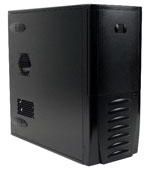 |
Our baseline recommendation has many similarities with the upgraded midrange configuration we used in our last buyers guide, including the use of the same 22" widescreen display from Acer and the Microsoft keyboard and mouse combo package. We have chosen a slightly different case and power supply, although the choice of case is going to be largely based on personal preference. The Antec SLK-3000 case is your classic steel Antec chassis with a black paint job: it's durable, easy to work with, and it includes a reasonably quiet rear 120mm fan with an additional 120mm fan mount at the front of the case. A second fan isn't absolutely required, but adding a lower RPM fan can help ensure that your components stay cool. As we are using multiple graphics cards in all the configurations, we felt a good-quality power supply was a required starting point. While just about any 500W or higher rated PSU is going to be sufficient, we wanted something relatively quiet that we were confident would last a long time.
(Ed: And we changed from the original PSU choice due to user feedback...) We selected the Seasonic S12-500 to go with the Antec case, as Seasonic is one of the most highly regarded PSU manufacturers around. 500W might seem low to some, but this is truly a 500W PSU with a high efficiency; it can really output 500W to all the peripherals - more than enough for the systems listed here today - and it will do so without drawing substantially more power from the outlet. We also added some basic 5.1 speakers from Logitech - something we omitted in the previous buyers guide.
(Ed: Sorry!) For the basic builds, we feel most users will be fine using integrated audio, so we are not listing a sound card, but you can see some options below.
| Upgraded High-End Case and Accessories |
| Display |
Acer 24" AL2416Wd 6ms 1920x1200 |
$686 |
| Case |
LIAN LI PC-7B plus II |
$100 |
| Power Supply |
OCZ GameXStream OCZ700GXSSLI 700W |
$130 |
| Keyboard and Mouse |
Logitech Keyboard and Mouse - Wireless + Rechargeable |
$56 |
| Sound Card |
Bluegears b-Enspirer |
$106 |
| Speakers |
Cyber Acoustics A-5640rb 5.1 |
$100 |
| Total |
$1178 |
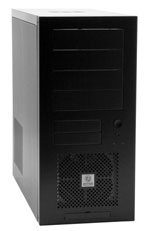 |
Stepping up one notch, we've moved up to a 24" LCD from Acer, sporting a native 1920x1200 resolution with a fast 6ms response time. With all the money spent on upgraded graphics cards, there's no point in not having a high-end display to help keep them busy! For the case, we chose the Lian Li PC-7B black aluminum enclosure. Lian Li has always been known for building high-quality cases, and this is no exception. Like the Antec we selected above, it includes two 120mm fan mounts at the front and rear of the case, only this time both fans are included. We upgraded the power supply one more notch to a 700W model, this time going with the OCZ GameXStream 700W as it is presently the lowest priced quality 700W PSU available. Thermaltake, Fotron Source, and several other manufacturers offer similar power supplies - in fact, most of these power supplies are simply tweaked Fotron Source designs, so if you can find one of those for less money there's little difference other than the name on the side of the PSU. For the input devices, we switched to a wireless Logitech keyboard and mouse, with the mouse including a recharging stand. Some people have other preferences as far as keyboards and mice go, so get what you're comfortable with.
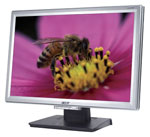 |
We've also upgraded the speakers, and we added a Bluegears b-Enspirer soundcard. A lot of you may not have heard of this soundcard yet, but it is definitely one to consider. It uses the new C-Media Oxygen HD CMI8788 audio chip and features real-time Dolby Digital and DTS encoding support. This is a great soundcard for anyone looking to put together an HTPC system, or anyone looking for better than integrated audio without the Creative Labs name. Feel free to upgrade the speakers to something better or use your home stereo system in order to take full advantage of this soundcard. If you're primarily concerned with gaming audio, the Sound Blaster X-Fi is still the better choice, but for light gaming and home theater use the Bluegears b-Enspirer is an excellent alternative.
| Upgraded #2 High-End Case and Accessories |
| Display |
Dell 2407WFP 24" 6ms GTG 1920x1200 |
$720 |
| Case |
Antec Performance I P180 |
$125 |
| Power Supply |
OCZ GameXStream OCZ700GXSSLI 700W |
$130 |
| Keyboard and Mouse |
Logitech MX3000 Wireless + Laser Mouse |
$63 |
| Sound Card |
Creative X-Fi XtremeMusic |
$114 |
| Speakers |
Logitech Z-5300e 5.1 |
$139 |
| Total |
$1291 |
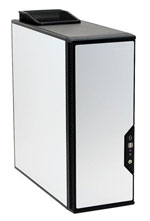 |
Most of the differences between this upgraded version and the previous upgraded version are slight. We've chosen the Dell 2407WFP 24" LCD, which we think looks a little bit nicer than the Acer, and it also includes a better stand and an integrated flash card reader. Are any of those changes required? No, but some of you will prefer the Dell display, and if you wait you might actually be able to find it for less money when Dell puts on one of their classic sales. We changed the case to an Antec P180, going for silver this time because not everyone likes black. (Make sure you get an appropriate optical drive faceplate if you choose this case!) The power supply remains the same, while we ditched the rechargeable wireless mouse for a wireless laser mouse. Finally, we upgraded the speakers another step to the Logitech Z-5300e. A little bit more money, a little bit better sound quality. We also chose a more gaming-centric sound card in the Creative Sound Blaster X-Fi XtremeMusic, which we would assume all of you are familiar with by now.
| Ultra High-End Case and Accessories |
| Display |
Dell 3007WFP 30" 11ms GTG 2560x1600 |
$1450 |
| Case |
Cooler Master Stacker 830 |
$243 |
| CPU Cooling |
Scythe Infinity |
$60 |
| Power Supply |
SilverStone SST-ST85ZF 850W |
$279 |
| Keyboard |
Microsoft Natural 4000 |
$43 |
| Mouse |
Logitech MX Revolution |
$90 |
| Sound Card |
Creative X-Fi Platinum |
$175 |
| Speakers |
Logitech Z-5500D 5.1 Digital Speakers |
$223 |
| Total |
$2563 |
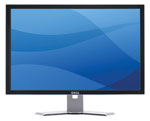 |
The Ultra accessories package is a great complement to the ultra high-end Intel configuration. In a similar fashion, we have maxed out just about every component, sometimes at significant expense. We have chosen the Cooler Master Stacker 830 for our top configuration, as it has a spacious interior and an attractive and easy to use design that's suitable for even the most high-end configurations. Yes, you could buy a different case, and as we often state what case is "best" is largely a matter of personal preference. For the display, the best computer deserves the best LCD currently available, so we have selected the Dell 3007WFP 30" LCD with a native 2560x1600 resolution (or WQXGA if you prefer). Definitely don't skimp on your GPU selection if you choose to go with this large monitor and plan on gaming at the native resolution!
We also jumped up to an 850W power supply from Silverstone, which costs almost twice as much as the 700W OCZ.
(Ouch!) However, with rumors circulating that the next generation high-end graphics cards from NVIDIA and ATI will
require even more power than the current models, we felt that any ultra high-end system needed a power supply equal to the task. (You could jump up to a PC Power & Cooling Turbo-Cool 1000W PSU if you really want to go extreme, but be prepared to fork over nearly $500 for the privilege!) The soundcard has been bumped up to the platinum edition of the X-Fi, which adds a 5.25" bay that provides front panel connections but is otherwise the same as the other X-Fi cards. For the speakers, we moved up to the Logitech Z-5500 digital speakers, eliminating the interference that can be generated by all of the electronic noise inside your computer case. Finally, for the user interface we went with Microsoft's Natural 4000 keyboard and coupled that with
Logitech's Revolution MX mouse, both of which are arguably best in class peripherals. However, personal preference still plays a role, so you might want to try out these devices in person at your local computer store.
CPU Cooling
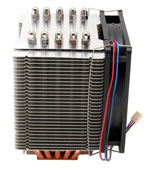 |
One item that we added to the ultra configuration that is worth considering for any of the system builds is an aftermarket heatsink to help keep your processor cool. If you are looking for the HSF that we currently feel is the best air cooling available, look no further than the Scythe Infinity. It is absolutely massive and definitely won't fit in every computer case out there - or on every motherboard - but if you are serious about overclocking then the $65 is money well spent. Another good alternative is the Tuniq Tower 120, which is unfortunately out of stock everywhere right now. We consider the Scythe Infinity to be the better CPU cooler, but the Tuniq Tower 120 is very good and might cost a bit less. Another competing solution (that's just as large as the Infinity) is the Thermalright Ultra-120, which typically equals the other two in cooling prowess and may cost a bit more or less depending on where you find it. For cases and motherboards that aren't quite as spacious, Zalman and Thermalright offer reasonably priced CPU coolers that will still outperform the stock heatsinks from both AMD and Intel.

















45 Comments
View All Comments
JarredWalton - Tuesday, October 10, 2006 - link
Seasonic makes PC Power and Cooling PSUs as far as I'm aware (I've seen it stated elsewhere, though nothing official from either company), along with Silverstone and a few others I believe. (I wouldn't be surprised if some of the other PSU manufacturers re-rate the power supplies to a higher wattage however.) While I'm sure there are some companies that would ask to get a lower cost PSU manufactured, I don't think anyone going to Seasonic is looking at price as a primary concern. I would wager heavily that the components that go inside a Seasonic PSU are identical to the components they put in a PC Power and Cooling PSU -- after all, once you're using the best components available, there's not much else to do. The only difference is that Seasonic uses 120mm fans these days, whereas PC Power and Cooling still uses 80mm fans I believe. (I know which of those two options I prefer!)In terms of efficiency, all of the high-quality PSUs are going to be 80 to 88%. As far as I understand it, the watt rating is still how much power the PSU can output to components, so basically less efficient PSUs will simply run hotter when outputting the same amount of power, and that the same time they will cost more money because they are consuming more power from the outlet. If that's correct, let's do a quick sample calculation:
75% efficiency with a 300W PC draw:
Wall power: 400W
24/7 Operational Cost: $28.80 per month ($.10 per kilowatt)
Yearly Cost: $345.60
85% efficiency with a 300W PC:
Wall power: 353W
24/7 Operational Cost: $25.42 per month ($.10 per kilowatt)
Yearly Cost: $305.04
Savings per year: $40.56
So yes, you can argue that buying high-efficiency power supply can pay for itself over the course of the year. Not that we're comparing a pretty average (75%) power supply a with a very good (85%) power supply, and we're also assuming 24/7 operation at a relatively high load. A lot of computers, including the basic AMD system, probably average closer to half that much power draw.
Something else worth mentioning is that most high-end power supplies -- the type that are supposed to be capable of outputting 700-1000W for example -- often have much lower efficiency ratings when they aren't being heavily loaded. Some PSU companies will actually tell you the efficiency rating at several different loads. Often, you will find that under moderate load even a high-quality 700 W power supply will only be about 70% efficient.
PC Power and Cooling aren't bad PSUs, but they are definitely overpriced relative to other options. Either the best power supply on the market? I don't personally think so, although they are *one* of the best. Given the choice between a high-quality Fotron Source (700 W model for instance) and the competing Seasonic or PC Power and Cooling model, I'm going to save you $50 and go with Fotron Source.
yyrkoon - Friday, October 13, 2006 - link
Well yeah, the more efficient PSU is going to save you money in a few years, but after a point, that doesnt bother me as much as the Typical PSU being rated at 25C. What does this mean? This means, that if ambient (inside the PC case ) is above 10-15C, your PSU, inside, is going to be over 25C, which means, you're going to be losing power, AND efficency.I dont recall the formula, but lets assume you lose 5% power per 5C over the rated maximum tempurature, and the temp inside the PSU is 30C. This basicly means IF your PSU is rated at 600W @ 25C, at 30C, its actually only capable of 570W maximum (continuous). Now, this may look fairly trivial, however, I'm thinking real world, its actually more than 1% loss per 1C.
Anyhow, it doesnt bother me one bit spending $200 us even on a PSU thats going to take care of my current system, and several afterwards.
yyrkoon - Friday, October 13, 2006 - link
PCP&C Started in a garage in 1981 (ish) in California. How long has Seasonic been around ? If you go to PCP&C's website, you can read an article written about how PCP&C got started, and why the owner/president is so 'anal' about certain issues. Some of which, I agree with.It's possible the plant in China that makes Seasonic PSUs also make PCP&C, but I hardly think they are re-branded. This is how it works, everyone (basicly) has thier PSUs made in China to reduce costs, and maximize profits, if someone TRIED starting a PSU manufactuering plant in the US, they would most likley go bankrupt, before they became noticed. Even the PSU companies CLAIMING to be in Tiawan, are actually just 'store fronts' for the actual part being manufactuered in China.
How do I know this you ask ? I've had a lengthy chat with a friend in person, who worked in the buisness, and described to me how it works. From the conversation, I gathered that PCP&C PSUs ARE designed by the US company, and the company also picks out he parts to be used etc, but everything gets sent over to China, is put together, and sent back to be sold. I suppose its even possible that Seasonic is the middle-man in all of this, but I will just about garuntee that the owner of PCP&C retains the IP for his designs, after all, he started off as an un-known Electronics Engineer, making quieter PSUs, that had longer hold up times for friends, before he got into the buisness (or so he claims, but I've zero reason to doubt the guy on his word here).
The way I see it, SOMEONE puts all the parts together, BUT PCP&C still makes thier own PSUs by design/parts.
Again, let me re-iterate, PSU efficeincy has to do with power lost to heat while converting AC -> DC ;)
BladeVenom - Monday, October 9, 2006 - link
I would rather go with the power supplies that you recommended in you midrange buyer's guide. Kingwin doesn't have a good reputation, and the last review I saw for one of their power supplies would make me hesitant to even use it in a low end PC. http://www.jonnyguru.com/PSU/Absolute600W/">http://www.jonnyguru.com/PSU/Absolute600W/Another thing that suprised me was the Bluegears b-Enspirer. It sounds interesting, but I could only find a couple of short reviews for it. Since you're recommending it, are you going to do a review of it soon?
KorruptioN - Monday, October 9, 2006 - link
Agreed. The Kingwin (based on a Superflower) isn't the best choice available. You guys seemed to pick it out based on the fact that it offered "600 Watts". It doesn't even offer a second PCI-E power connection (according to JonnyGURU's review). Combined with the 30A +12V rating, it isn't good enough for dual-GPU configurations, IMO.Antec's NeoHE 500W (in the later revisions) or one of XClio's modular PSUs are better overall choices, I think.
JarredWalton - Monday, October 9, 2006 - link
I'm quite sure that the Kingwin does have dual PCIe plugs: http://www.kingwin.com/pdut_detail.asp?LineID=&...">Specifications. Perhaps JohnnyGuru got an early revision that was messed up - that happens more often than I'd like with hardware review sites, as we often get product before it's publicly available. Obviously, it's the "low-end" of this roundup, which means part of the choice was made for pricing reasons. I guess I forgot to make my standard disclaimer clearly visible:Fotron Source, Seasonic, Enermax, and a variety of other PSU manufacturers (well, a lot of them are just rebranded Fotron Source or some other OEM design) are good choices that will almost always cost a bit more money. For the baseline AMD model, you certainly don't need a 600W PSU. If you're looking to upgrade in the future and keep the PSU, getting something better is recommended.
That said, I'll pop out the Kingwin and put something else in there. I'm not going to go with PCP&C for the price, that's for certain. They make fine power supplies (well, Seasonic does), but while they warrant a mention on the Ultra configuration, they can't really fit into an ~$2000 budget without having to sacrifice other areas just to accommodate a PSU that's overkill. Hopefully you're all happy with spending $35 more to go from an okay Kingwin 600W to a great Seasonic 500W. :)
KorruptioN - Monday, October 9, 2006 - link
Jarred, you're linking to a different PSU altogether. You are linking to the ABT-600MM, where the original PSU selection in this PC guide was the ABT-600CW. It does look like the specification has been updated to include two 6-pin PCI-E power connections, but that doesn't really change the fact that it doesn't have a lot of juice where it matters the most.Either way, good choice on that Seasonic S12-500. How about the new M12-500? Or is that too much to ask :P
JarredWalton - Monday, October 9, 2006 - link
Ah, then the mistake was yours (well, someone's anyway - whoever linked the JohnnyGury review). The original PSU was indeed the Kingwin Maximum Power ABT-600MM 600W -- I have the spreadsheet right in front of me, and I'm sure it was not the CW version. Figures; people like to get up in arms over PSUs, but then they rarely do anything more than say "OMG it's not a Seasonic/[insert favorite brand]!". You can get the ABT-600MM http://www.xpcgear.com/abt600mm.html">right here - that's the price I used in the original text.Gary Key - Monday, October 9, 2006 - link
Yes, we will be reviewing it in the coming weeks. While not in the same class as the X-FI for gaming, it is better than the on-board solutions while providing just about every option you would want in a HTPC card considering the price.
poohbear - Monday, October 9, 2006 - link
hate to point this out about this whole article, but if price was'nt an issue, wouldnt i just buy something prebuilt from falcon northwest, voodoo pc, or alien ware? im not sure which audience this article caters to, but i doubt they're a DIY audience that follows anandtech.